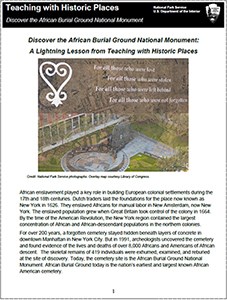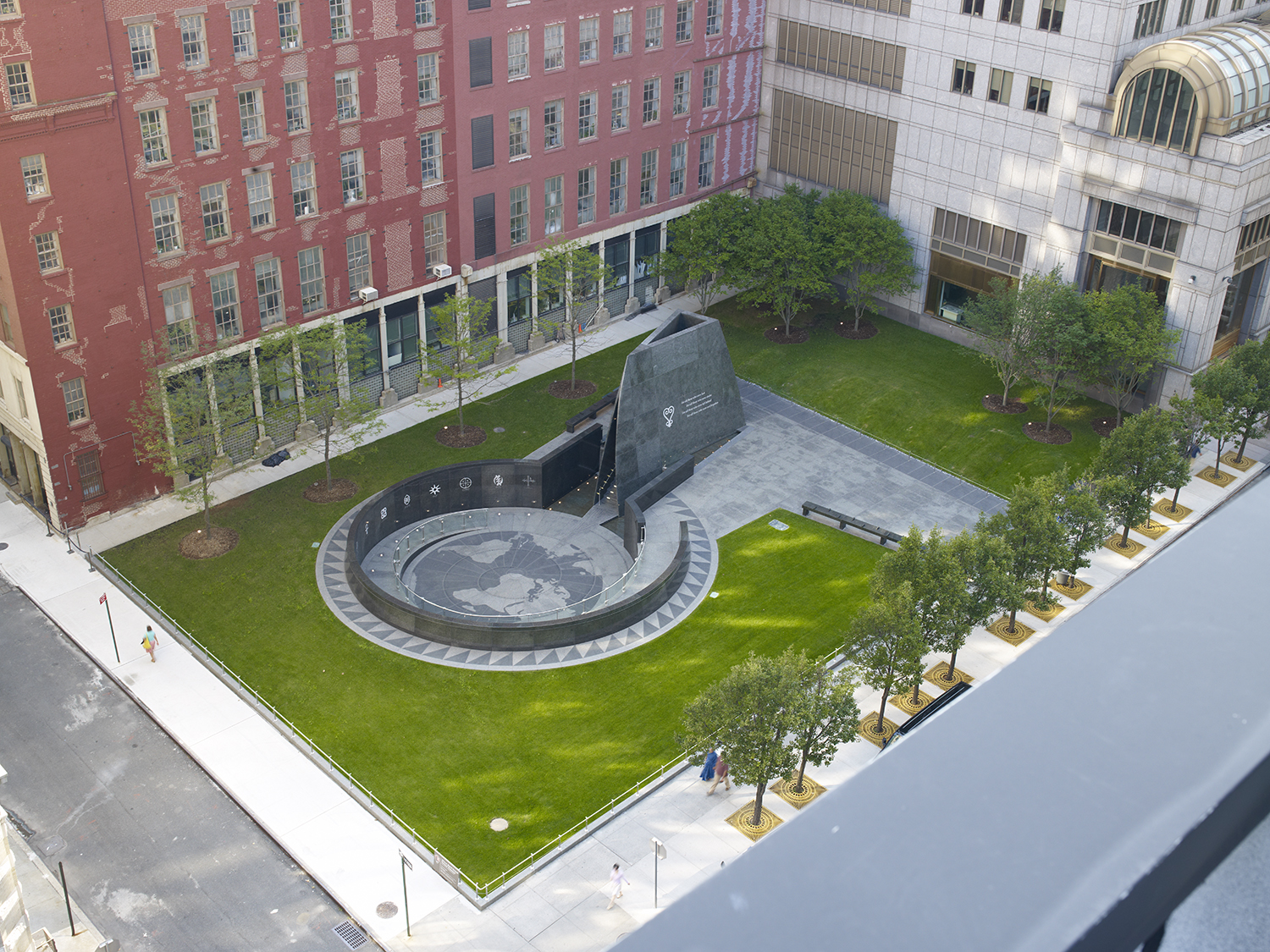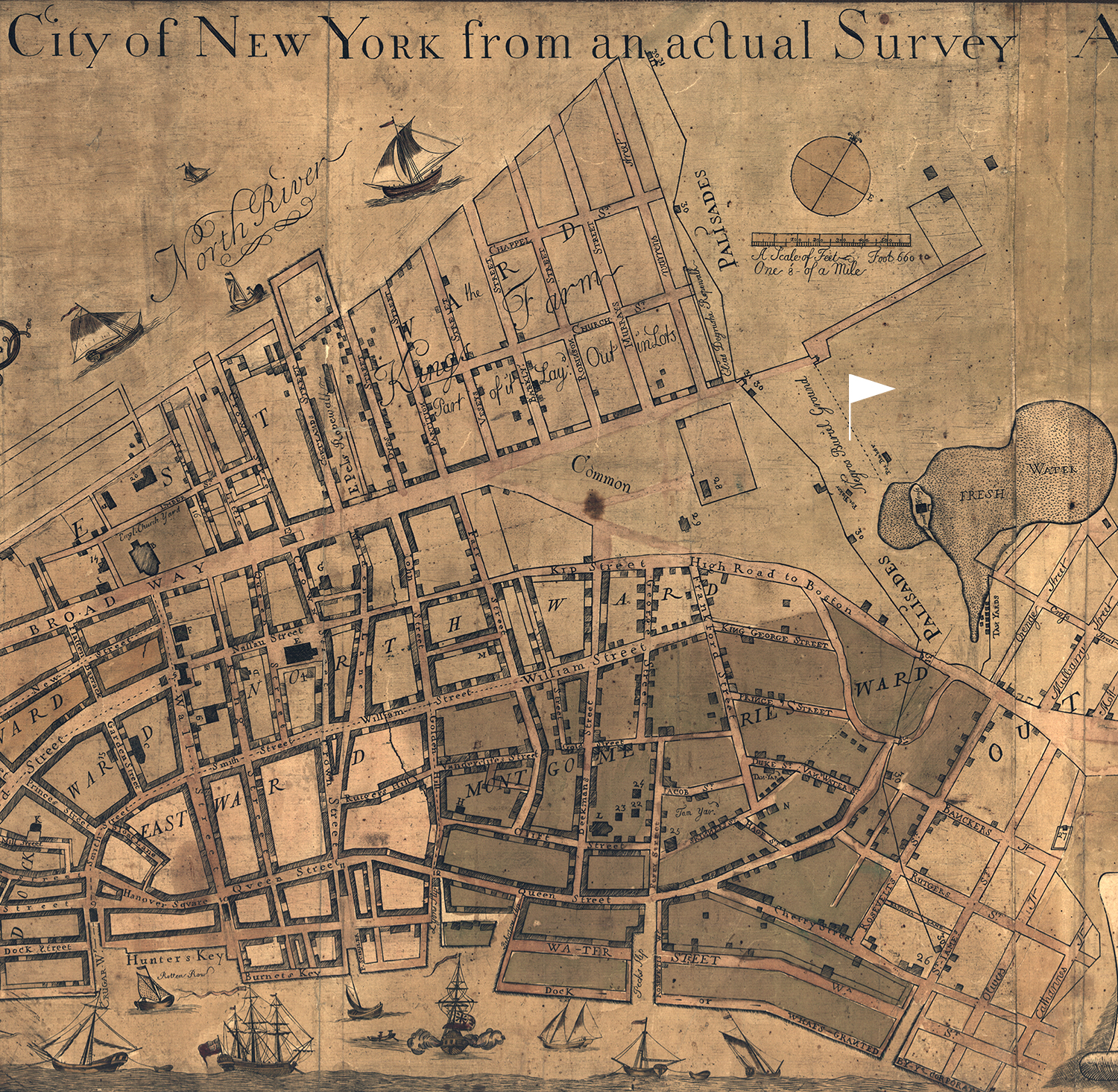
(Credit: National Park Service)
Contents
| Introduction
| Materials in the Lesson (Maps, Readings, Visual Evidence)
| Post-Lesson Activities
| Where it Fits Into the Curriculum (Objectives and Standards)
| More Resources
| About
How do Americans show respect for the bodies and memories of the deceased?
African enslavement played a key role in building European colonial settlements during the 17th and 18th centuries. Dutch traders laid the foundations for the place now known as New York in 1626. They enslaved Africans for manual labor in New Amsterdam, now New York. The enslaved population grew when Great Britain took control of the colony in 1664. By the time of the American Revolution, the New York region contained the largest concentration of African and African-descendant populations in the northern colonies.
For over 200 years, a forgotten cemetery stayed hidden beneath layers of concrete in downtown Manhattan in New York City. But in 1991, archeologists uncovered the cemetery and found evidence of the lives and deaths of over 8,000 Africans and Americans of African descent. The skeletal remains of 419 individuals were exhumed, examined, and reburied at the site of discovery. Today, the cemetery site is the African Burial Ground National Monument. African Burial Ground today is the nation’s earliest and largest known African American cemetery.
Materials Found in the Full Lesson
Accompanying Question Sets are paired with all materials in the Full Lesson (PDF).
Map 1: Map of the "Plan of the City of New York, 1755," a primary source document depicting the city as it was during the Colonial Era and edited to mark the location of the African Burial Ground.
• Text: Primary and secondary source readings provide content and spark critical analysis.
Reading 1: Essay, “Rediscovering the African Burial Ground” by the National Park Service.
Reading 2: Primary source document, "Schedule-of-Events for the 'Rites of Ancestral Return'” from the Shomburg Center for Research in Black Culture.
Photo 1: Photograph of African Burial Ground National Monument, 2009, by Carol M. Highsmith (Library of Congress).
• Activity 1: Tracing Paths and Exploring Destinations of the Middle Passage
• Activity 2: Honoring Ancestors through Poetry
• Activity 3: Investigating Local and Regional History through Archeology
Where it Fits into the Curriculum
This lesson can be used in middle and high school units about African and American histories, the Middle Passage and Slavery, and local cultural investigations.
Time Period: Seventeenth and Eighteenth Century Colonial Era, contemporary era.
Objectives
1. To explain how and why African cultures are present in American culture;
2. To describe the African Burial Ground National Monument and archeological evidence found at the site;
3. To identify the ways people memorialized the dead at the “Negros Buriel Ground” in colonial New York and the ways people memorialized the African Burial Ground National Monument.
4. Investigate, analyze, and report on one of three topics covered in an optional activity: 1) Investigate the experiences of the Middle Passage in a global context; 2) Commemorate personal heritage through poetry; 3) Investigate local archeological evidence of spiritual practices.
National Standards for History, Social Studies, and Common Core
• Standard 3B: The student understands economic life and the development of labor systems in the English colonies.
• Standard 3C: The student understands African life under slavery.
This lesson relates to Thematic Strands from the National Council for the Social Studies' National Standards:
• Theme II: Time, Continuity, and Change; Standards D-F
• Theme III: People, Places, Environments; Standards A, C, G-I
• Theme V: Individuals, Groups, & Institutions; Standards B, F,
• Theme VI: Power, Authority, and Governance; Standard H
• Theme VIII: Science, Technology, & Society; Standards A-C
This lesson relates to the Common Core Standards in History/Social Studies (6-8, 9-10, 10-11):
• CCCSS.ELA-Literacy.RH.6-12.1
• CCSS.ELA-Literacy.RH.6-12.2
Integration of Knowledge and Ideas
• CCSS.ELA-Literacy.RH.6-12.7
See the Full Lesson (PDF) for details about how the these Standards and Themes relate to the lesson. Search our Lesson Plans by National History Standards or Lesson Plans by Social Studies Standards to identify lessons that correspond with the eras and themes you want to teach.
The African Burial Ground National Monument is a National Park Service unit and part of the National Parks of New York Harbor. Visit its website to learn more about the history and culture of the historic site, or to get in touch with rangers and interpreters who specialize in Colonial New York history and African Burial Ground topics.
National Parks Conservation Association
African Burial Ground National Monument was featured in the “hidden treasures” of New York video series, produced by the National Parks Conservation Association (a non-government advocacy organization). The virtual tour of the historic Manhattan cemetery is available on YouTube.
NPR
National Public Radio produced a 5-minute audio feature story in October 2003 about African Burial Ground : “New York Reburies Remains of Colonial-Era Blacks”. The feature piece quickly covers the site's history and preperations for the Rites of Ancestral Return, including interviews with New York residents and preservationists to reveal perspectives on the reburial.
Also from NPS, a 12-minute online radio story about the history of slavery in New York and the creation of the monument: “Unearthing New York’s Forgotten Slavery Era”. The story features interviews with two men who led the movement to create the ABGNM, Michael Blakely and Howard Dodson.
The Schomburg Center for Research in Black Culture at The New York Public Library
The New York Public Library’s Shomburg Center published an online exhibit about the African Burial Ground. The exhibit showcases images of the burial sites and artifacts found during the excavations, as well as videos from the October 2003 Rites of Ancestral Return.
New York Historical Society
Access historical maps of “Black New York City” during the years 1785 to 1835, digitized by the New York Historical Society. The maps highlight schools, churches, theaters, newspaper companies, bookshops, and mutual-aid societies created by black New Yorkers in the late eighteenth and early nineteenth centuries in Manhattan.
The New York Historical Society’s past exhibit about slavery in the city is available in digital form. The resource offers online resources for teachers, including lesson plans and primary sources about the history of slavery in New York City.
University of Virginia Library and The Virginia Foundation for the Humanities
The Digital Media Lab at the University of Virginia Library and the Virginia Foundation for the Humanities produced a database of over one thousand historic photographs of the transatlantic slave trade, enslaved Africans in the Americas, as well as contemporary drawings of these experiences.
This lesson plan is based on the National Register for Historic Places nomination for the African Burial Ground in New York City, New York. Discover the African Burial Ground: A Lightning Lesson from Teaching with Historic Places was published in 2017. It was written by Dr. Beth Pruitt, National Park Service contractor, and developed by Historical Anthropologist Maria Lee Strohmayer and NPS historian Katie Orr. Editing assistance came from Northeast Regional Office, National Parks of New York Harbor, and Cultural Resources Office of Interpretation and Education staff in D.C. This lesson is one in a series that brings historic places to students around the world.
Last updated: September 26, 2024


